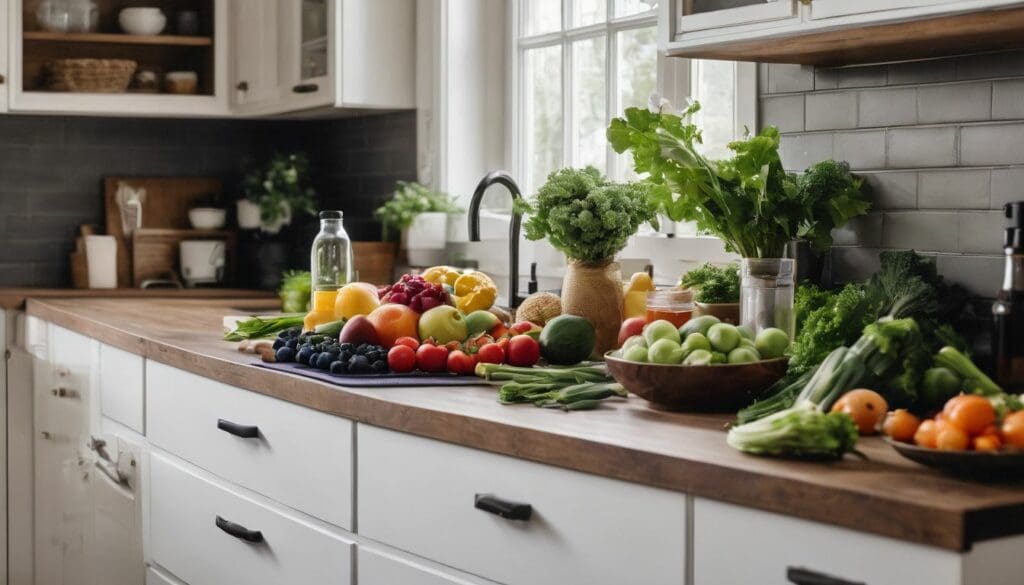In our daily lives, we’re surrounded by a cocktail of chemicals – from the shampoo we use to the food packaging sitting on our kitchen shelves. Without realising it, toxic substances such as organophosphates and flame retardants seep into our routines.
As an environmental scientist with over a decade of experience studying chemical pollutants, I’ve seen first-hand how these hidden dangers affect both people and the planet.
Understanding what lurks within everyday items is essential for protecting your health and preserving our environment. Did you know that some products labelled ‘green’ or ‘natural’ can still contain harmful ingredients? The key to avoiding the toxin trap lies in discerning which products are genuinely safe.
Let’s explore how to become more vigilant about what comes into contact with our lives, ensuring a healthier future for us all. Read on – your well-being may depend on it!
Key Takeaways
- To reduce the risk of harmful chemical exposure, choose organic produce and use glass or stainless steel containers instead of plastic for food storage.
- Opt for personal care products that are labelled as phthalate-free or paraben-free to avoid hormone disruption and other health issues.
- When purchasing furniture, look for items made without flame retardants and choose natural materials like solid wood or organic cotton upholstery.
- Create your own household cleaning products using safe ingredients such as vinegar and baking soda to lessen reliance on commercial cleaners with toxic substances.
- Advocate for clearer labelling on products so that consumers can make informed decisions about the chemicals in items they purchase.
The Hidden Dangers of Everyday Chemicals
Organophosphates, flame retardants, and phthalates are just a few of the harmful chemicals found in everyday products that can lead to serious health issues. These toxins are commonly present in household items, personal care products, and even food packaging.
Organophosphates
Organophosphates lurk in various products, from insecticides to cleaning agents. These chemicals were originally developed for warfare but have since been adapted for agricultural use.
They attack the nervous system of pests but can also affect human health if exposure is high enough. People encounter organophosphates through foods that have been treated with these chemicals or when using certain bug sprays and lawn treatments.
Exposure to organophosphates poses risks such as headaches, dizziness, and at high levels, respiratory problems or even nerve damage. This makes it important for individuals who are environmentally conscious to stay informed and take steps towards a toxin-free living environment.
The next potential hazard hidden in everyday items goes by the name ‘flame retardants‘ – substances designed to slow ignition and prevent fires which carry their own set of concerns.
Flame retardants
Flame retardants are commonly found in household items like furniture, electronics, and textiles. These chemicals are added to materials to reduce the flammability of products, but they can pose health risks when they leach into the environment or come into contact with our bodies.
Studies have linked flame retardant exposure to hormone disruption, developmental delays in children, and even certain types of cancer. To minimise exposure to these toxic substances, look for products that are labelled as flame retardant-free and opt for natural alternatives whenever possible.
When considering everyday items such as furniture and electronics, it’s important to be aware of potential harmful chemicals like flame retardants and choose safer options that align with a toxin-free lifestyle.
Phthalates
Phthalates, found in many household items like plastics, can leach out and contaminate the environment. These harmful chemicals are also used in personal care products such as perfumes and lotions.
Phthalates have been linked to hormone disruption and respiratory issues, making it crucial to avoid products containing them. Making informed choices by reading product labels for phthalate-free options is essential for reducing exposure to these toxins and supporting a healthier lifestyle.
By choosing phthalate-free alternatives for plastic products and personal care items, individuals can minimise their exposure to these harmful substances. Additionally, advocating for clearer labelling requirements can empower consumers to make informed decisions when selecting everyday products.
Common Sources of Toxic Chemicals
Common sources of toxic chemicals include food, plastics, furniture, food wrapping, personal care products, and household products. These items may contain harmful substances that can enter our bodies through ingestion, skin absorption, or inhalation.
Food
To reduce exposure to toxic chemicals in food, opt for organic produce as it is grown without synthetic pesticides and fertilisers. Choose glass or stainless steel containers over plastic for storing and reheating food to avoid harmful chemicals leaching into your meals.
When cooking, use non-toxic cookware such as ceramic or cast iron, which do not release hazardous substances when heated. It’s also essential to be vigilant about checking food labels for artificial additives, preservatives, and other potentially toxic ingredients that could harm your health.
Being mindful of the sources of toxins in the foods you consume is crucial for maintaining a toxin-free lifestyle.
Plastics
Plastic products often contain hazardous additives, such as phthalates and heavy metals, which can gradually seep out over time. These toxic substances pose a risk to human health and the environment.
By being aware of the chemicals present in plastic items and opting for eco-friendly alternatives, we can reduce our exposure to harmful toxins in our daily lives. Making informed choices about the products we use is crucial in preventing chemical pollution and protecting ourselves from the potential dangers of these poisonous compounds.
Understanding that plastics may leach out harmful chemicals is an important step towards minimising chemical exposure at home while supporting conservation efforts. Choosing nontoxic products, free from dangerous additives, not only safeguards our health but also contributes to a cleaner environment by reducing chemical pollution.
Furniture
Furniture can be a significant source of exposure to harmful chemicals in the home. Many furniture items, including sofas, chairs, and mattresses, are treated with flame retardants that contain toxic substances known as polybrominated diphenyl ethers (PBDEs), which have been linked to adverse health effects.
When purchasing new furniture, it’s important to look for products made without these chemicals and opt for natural materials like solid wood or organic cotton upholstery. Furthermore, choosing furniture certified by eco-friendly labels ensures that it meets stringent standards for chemical content and environmental impact.
In addition to considering the materials used in furniture manufacturing, it’s crucial to pay attention to the adhesives and finishes applied during production. Some adhesives may contain volatile organic compounds (VOCs) that release into the air over time, contributing to indoor air pollution.
Food wrapping
Food wrapping can introduce harmful chemicals into our food. Plastic wraps and containers may contain phthalates, which can leach into food, especially when heated. These compounds have been linked to hormone disruption and other health issues.
Choosing eco-friendly alternatives like beeswax wraps or glass containers can help reduce exposure to these toxins.
Understanding the potential dangers of food wrapping materials is crucial for protecting ourselves from harmful chemical exposures. Next, let’s explore how personal care products also play a significant role in introducing toxins into our daily lives.
Personal care products
After being mindful of toxic substances in food wrapping, it’s equally important to pay attention to personal care products. Many personal care items contain harmful chemicals like phthalates and parabens that can disrupt hormone function and have been linked to adverse health effects.
Be cautious about the ingredients in your shampoo, lotion, deodorant, and makeup products to minimise exposure to these toxic substances.
Reducing chemical exposure from personal care products is crucial by choosing eco-friendly alternatives or making your own natural skincare products. Opt for fragrance-free options and look for labels indicating “phthalate-free” or “paraben-free.” This small step can significantly contribute towards keeping yourself and the environment toxin-free.
Household products
Household products can be a significant source of toxic chemical exposure. Many cleaning agents, air fresheners, and pesticides contain harmful substances such as phthalates and volatile organic compounds (VOCs).
These chemicals can easily enter our bodies through inhalation and skin absorption. Phthalates, found in fragranced household items, are known to disrupt hormones and have been linked to reproductive issues.
In addition, flame retardants commonly used in furniture pose health risks when they break down into dust particles that we inhale or ingest.
It’s essential to be vigilant about the products we use at home, opting for eco-friendly alternatives whenever possible. Look for labels indicating BPA-free plastics, choose fragrance-free options, and read product labels carefully for any toxic ingredients.
How Chemicals Get into Our Bodies
Toxins can enter our bodies through ingestion, absorption through the skin, and inhalation. Interested in learning more about ways to reduce your exposure to harmful chemicals? Keep reading for valuable insights and tips.
Ingestion
Toxic chemicals can enter our bodies through ingestion when we consume food and drinks that have been contaminated with harmful substances. For example, pesticide residues on fruits and vegetables or toxins leaching from plastic containers into the food they hold can pose health risks.
It’s important to be mindful of the sources of our food and drink, opting for organic produce and using glass or stainless steel containers instead of plastic to minimise exposure.
Ingesting toxic chemicals can lead to serious health effects, including disrupting hormone function, causing reproductive issues, and increasing the risk of cancer. By being aware of potential contamination in daily consumables and making conscious choices about what we eat and drink, we can significantly reduce our exposure to harmful toxins.
Absorption through skin
Household products, personal care items, and even clothing can introduce toxic chemicals into our bodies through skin absorption. Research confirms that certain chemicals commonly found in everyday products can permeate the skin and enter the bloodstream.
For instance, phthalates are a group of chemicals used to soften plastics and can be found in fragrances, lotions, and cosmetics. These substances have been known to disrupt hormones and cause adverse health effects.
Additionally, some flame retardants present in furniture and textiles have been linked to serious health concerns like developmental delays and reproductive issues.
To avoid such exposures, start by choosing eco-friendly personal care products free from harmful substances like phthalates. Opt for natural fabrics over chemically-treated ones when it comes to clothing choices.
Inhalation
Toxic chemicals can enter our bodies through inhalation, meaning breathing in harmful substances found in the air. Dangerous compounds like volatile organic compounds (VOCs) released from cleaning products, paints, and air fresheners can be inhaled.
Additionally, flame retardants used in furniture and phthalates found in plastics can be released into the air and then breathed in. These chemicals have been linked to various health issues such as respiratory problems, reproductive disorders, and even cancer.
To reduce your exposure to these toxins through inhalation, opt for natural cleaning products without strong chemical odours or VOCs. Keep indoor spaces well-ventilated by opening windows or using an air purifier to minimise the concentration of toxic airborne particles.
Steps to Reduce Exposure to Toxic Chemicals
Reduce your exposure to toxic chemicals by making your own cleaning products, choosing BPA-free products, avoiding fragrance, reading product labels, and using household air purifiers.
Make your own cleaning products
Creating your own cleaning products is a simple and effective way to reduce exposure to harmful chemicals in everyday life. By using natural ingredients like vinegar, baking soda, and essential oils, you can avoid the toxic substances found in many commercial cleaners.
Not only are homemade cleaning products safer for the environment, but they are also cost-effective and easy to make at home. With just a few basic ingredients, you can create powerful cleaners that effectively remove dirt and grime without posing any risk to your health or the environment.
Avoid fragrance
When making your own cleaning products or choosing less toxic alternatives, it’s crucial to avoid fragrance. Many fragranced products contain harmful chemicals such as phthalates and synthetic musks which have been linked to hormone disruption, allergies, and asthma.
By opting for fragrance-free options, you can minimise exposure to these toxins while still maintaining a clean and fresh environment in your home. Look for products labelled “fragrance-free” or make natural cleaning solutions using ingredients like vinegar, baking soda, and essential oils for a healthier living space.
Choosing BPA-free products is beneficial for avoiding harmful toxins.
Choose BPA-free products
Selecting BPA-free products is crucial for reducing exposure to harmful chemicals. Bisphenol A (BPA) is commonly found in plastic containers and can leach into food and drinks, leading to potential health risks.
Opting for BPA-free alternatives can help minimise this risk and promote a safer living environment for you and your family.
By choosing BPA-free products, individuals can actively contribute to minimising their exposure to toxic substances while supporting eco-friendly alternatives. Many brands now offer a wide range of BPA-free items, including water bottles, food storage containers, and baby bottles, making it easier than ever to make the switch towards a healthier lifestyle.
Read product labels
To reduce your exposure to harmful chemicals, always read product labels. Look for information on ingredients and potential toxins. By doing so, you can make informed choices and select safer alternatives that are free from dangerous substances.
Understanding what goes into the products you use every day allows for better decision-making and empowers you to protect yourself from harmful chemicals, ultimately contributing to a healthier environment overall.
Moving forward with “Request for information on product ingredients”, take charge of your well-being by seeking transparency in the products you bring into your home.
Request for information on product ingredients
When purchasing household and personal care products, it’s essential to request information on product ingredients. By doing so, you can make informed decisions about the substances you bring into your home environment.
Understanding the components of these items empowers you to choose products that align with your goal of reducing chemical exposure in everyday life. This simple action also encourages manufacturers to prioritise transparency and develop safer, eco-friendly alternatives.
Ultimately, requesting ingredient information contributes to a collective effort in creating a marketplace for toxin-free living.
Additionally, be proactive in seeking out detailed ingredient lists for the products you use daily. Educating yourself about hidden chemicals within these items is crucial for promoting consumer safety and environmental wellness.
Use household air purifiers
To further minimise exposure to harmful chemicals, consider using household air purifiers. These devices are designed to remove particles like dust, pollen, and smoke from the air in your home.
This can be particularly beneficial for individuals sensitive to airborne allergens or those looking to reduce indoor air pollution levels caused by everyday products.
With household air purifiers, you can effectively improve the quality of the air you breathe at home. By removing potentially harmful particles and pollutants, these devices contribute to creating a safer environment for you and your family.
Taking Action Against Toxic Chemicals
Individuals can take action against toxic chemicals by advocating for state and national level policies and regulations, making informed choices about the products they use, and demanding less toxic alternatives from manufacturers.
Taking a stand against harmful chemicals in everyday products is an important step towards creating a safer and healthier environment for everyone.
State level policies and regulations
State level policies and regulations play a crucial role in protecting individuals from harmful chemical exposure. These policies not only aim to reduce the presence of toxic chemicals in everyday products but also ensure that manufacturers adhere to strict guidelines for product safety.
By implementing robust state-level regulations, authorities can create a safer environment for consumers while promoting the use of eco-friendly alternatives. Additionally, these policies provide an opportunity for citizens to advocate for stronger chemical management rules at the local level, ultimately contributing to a healthier and more sustainable community.
Moving Beyond State Borders: National Policies and Regulations
National level policies and regulations
National level policies and regulations play a crucial role in reducing the presence of toxic chemicals in everyday products. By implementing stringent standards for chemical use and manufacturing processes, governments can protect consumers from harmful substances.
These regulations also drive industries to adopt safer alternatives, leading to the availability of toxin-free consumer products that are eco-friendly and safe for daily use.
Research into household exposure is key to informing improved national-level policies and regulations. This data can guide decision-makers in creating effective strategies for managing and minimising the presence of toxic chemicals in our environment.
Understanding the impact of these policies on public health is essential for continuous improvement in chemical management at a national level.
Individual behaviour change
To reduce exposure to harmful chemicals, individuals can make simple changes in their daily habits. Choosing natural, chemical-free cleaning products and personal care items is an effective way to limit toxin intake.
Reading product labels and requesting information on ingredients can also help consumers make informed choices about the products they bring into their homes. Additionally, opting for eco-friendly alternatives and avoiding fragrance in household items are practical steps towards minimising chemical exposure.
By taking control of their purchasing decisions and being mindful of the substances present in everyday products, individuals can play a crucial role in protecting themselves from toxic chemicals.
Implementing individual behaviour change is vital for minimising chemical exposure and promoting toxin-free living. Making conscious choices such as using BPA-free products, reducing plastic use, and embracing eco-friendly alternatives empowers individuals to create healthier environments for themselves and their families.
Being aware of the potential hazards posed by everyday items like food wrapping materials or personal care products can motivate environmentally conscious individuals to opt for safer options that align with their values of conservation and environmental protection.
Choosing less toxic alternatives
To reduce your exposure to harmful chemicals, consider choosing less toxic alternatives for everyday products. Eco-friendly options like plant-based cleaning products and organic personal care items can help minimise chemical exposure in your home.
Opting for BPA-free plastics and seeking out fragrance-free products are simple yet effective ways to reduce toxic chemical intake.
When replacing household items, choose ecofriendly materials such as bamboo, glass, or stainless steel instead of plastic. Look for non-toxic building materials when renovating or furnishing your home and consider natural fabrics for bedding and clothing.
Speaking out and demanding change
To protect ourselves and our environment from harmful chemicals, it is crucial to speak out and demand change. By advocating for stricter regulations at the state and national levels, we can push for safer products and a healthier environment.
Additionally, raising awareness among individuals about the dangers of household chemicals can lead to more informed consumer choices and a collective demand for toxin-free alternatives.
Encouraging companies to disclose product ingredients empowers consumers to make educated decisions while also compelling manufacturers to prioritise eco-friendly formulations. Taking action against toxic chemicals involves not only individual behaviour change but also active engagement in policy-making processes, paving the way towards a safer and cleaner future for all.
Conclusion
In conclusion, reducing exposure to harmful chemicals is achievable through conscious consumer choices and advocating for safer products. Individuals can take charge by making informed decisions about the products they bring into their homes.
By demanding transparency from manufacturers and supporting policy changes, we can work towards a healthier environment for ourselves and future generations. Making small changes in our daily routines has the power to create a big impact on minimising toxic chemical exposure.
It’s important to stay informed and empowered in order to protect ourselves from the toxin trap lurking in everyday items.
FAQs
1. What does ‘The Toxin Trap’ mean in daily life?
‘The Toxin Trap’ refers to the risk of toxin exposure from harmful substances found in everyday items, including household products.
2. How can I prevent chemical exposure at home?
You can reduce chemical exposure by choosing eco-friendly alternatives and staying informed about safe consumer products.
3. Are there specific strategies to avoid toxic chemicals?
Yes, you can adopt ways to minimise your exposure to environmental toxins and maximise toxin-free living with careful product choices and a chemical detox mindset.
4. Why should I worry about toxins in my daily environment?
Harmful effects of everyday chemicals can impact your health, so protecting yourself from these poisonous chemicals is essential for well-being.
5. Can minimising exposure to toxic substances make a big difference?
Definitely! Minimising exposure helps you lead a healthier life free from the potential hazards posed by toxic chemicals lurking in common products.





